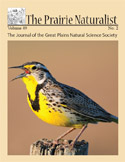Great Plains Natural Science Society

The Prairie Naturalist
Date of this Version
12-2011
Document Type
Article
Citation
The Prairie Naturalist 43(3/4):124–126. December 2011
Abstract
The plains pocket mouse, Perognathus flavescens, is a nocturnal granivore that inhabits friable soils in sparsely vegetated areas (Monk and Jones 1996). In the United States, the distribution of the plains pocket mouse extends from Arizona, New Mexico, and Texas through the Great Plains to North Dakota and Minnesota (Hall 1981). This species reaches its easternmost limits in Iowa, where it has been documented from a limited number of grassland sites in eastern, central, and western parts of the state (Bowles 1975, Wilson et al. 1996). Due to loss of grassland habitat, the plains pocket mouse is currently listed as an Endangered Species in Iowa (Iowa Legislature 2009). Because this species is rarely captured in the state (Wilson et al. 1996), little is known about its natural history in Iowa, including details of seasonal activity.
Many species of Perognathus are true hibernators and become seasonally dormant during winter (French 1993). Pocket mice store food in their burrows and alternate between episodes of torpor and euthermia to make their stored food last throughout dormancy (French 1993). The plains pocket mouse likely hibernates throughout its range, but timing of dormancy varies among populations (Monk and Jones 1996). From Kansas to Minnesota, the plains pocket mouse appears to enter dormancy in autumn. For example, the latest date of capture is 11 November in Kansas (Reed and Choate 1986) and 26 November in Nebraska (K. Geluso, University of Nebraska at Kearney, personal communication). We suspect that plains pocket mice in other populations north of Kansas enter dormancy in autumn; however, the latest reported date of capture in Iowa is 7 September (Wilson et al. 1996). Hence, our objective was to estimate the timing of seasonal dormancy in a population of plains pocket mice in Iowa. Also, we present observations on reproduction and foraging by individuals in late summer and autumn.
Included in
Biodiversity Commons, Botany Commons, Ecology and Evolutionary Biology Commons, Natural Resources and Conservation Commons, Systems Biology Commons, Weed Science Commons


Comments
Published by the Great Plains Natural Science Society, 2011. Used by permission.